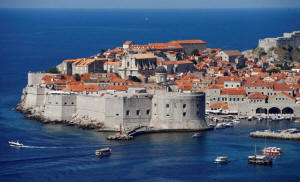|
Europe's tourist hot spots look for ways
to cope with the crowds
 Send a link to a friend
Send a link to a friend
 [March 13, 2018]
By Maria Sheahan and Victoria Bryan [March 13, 2018]
By Maria Sheahan and Victoria Bryan
BERLIN (Reuters) - Europe's tourist hot
spots are looking for new ways to cope with "overtourism," where cities
like Venice, Dubrovnik and Barcelona are struggling to manage huge
crowds arriving daily on cheap flights and cruise ships.
They are turning to smartphone apps and car-sharing promotions to try to
cope with the overcrowding, which has upset the local population and
also the tourists.
Some 9 percent of travelers who took part in a survey by consultancy IP
said that overcrowding affected the quality of their trip last year.
Security concerns over beach destinations in Egypt and Turkey and a rise
in cheap flights have boosted growth in international arrivals to
countries like Spain and Croatia to more than 10 percent over the past
few years, according to data from the United Nations World Tourism
Organization (UNTO).
"Overcrowded destinations are successful, but there is a thin line
between success and failure," Dubrovnik mayor Mato Frankovic told
Reuters at the IT travel trade fair in Berlin.

But rather than trying to limit the number of visitors, who spend money
on hotels, meals and souvenirs, the cities are coming up with ways to
channel tourist flows away from the most popular attractions.
Dubrovnik aims to launch a smartphone app by the end of 2018 that lets
users know when the narrow alleys of the old town are crowded and
suggests alternative sights outside the city walls.
It also plans to test a car-sharing scheme to entice tourists to explore
the surrounding areas.
Barcelona is working on a joint marketing plan with the region around
the city to get tourists to venture beyond the city's most famous sites
such as the Saga Familial church or the Las Rambles boulevard.
"Barcelona is small but the destination of Barcelona is beyond the city
and has a lot of attributes and attractions," said Barcelona Tourism
director Joan Tortilla Rene.
Even New York City, across the Atlantic Ocean, has launched a campaign
to encourage tourists to explore the boroughs beyond Manhattan and the
Statue of Liberty.
It is also trying to lure more visitors during off-peak times in January
and February, for instance, with events such as New York Restaurant Week
and Broadway Week.
"That really helps give visitors tremendous value and helps us fill the
slower periods," Christopher Heywood, a spokesman for New York City's
official tourism organization NYC & Company, told Reuters.
CRUISE CONTROL
The booming cruise industry is one of the biggest challenges for some
cities.
In Dubrovnik, multiple cruise ships often disgorge thousands of
passengers in one day, making the city's streets noisy and overcrowded.

[to top of second column]
|

A general view of Croatia's UNESCO protected medieval town of
Dubrovnik August 28, 2012. REUTERS/Marko Djurica/File Photo /File
Photo

The city is now trying to stagger the arrival of the ships and
eventually to ensure arrivals are spread evenly throughout the week
so that there won't be 10 ships coming to port at the same time.
Venice has drawn up new rules requiring big cruise ships to take a
less glamorous route to the industrial port of Marghera, rather than
passing by St. Mark's Square.
Some travel companies are also playing a role in the battle against
overtourism.
Ctrip, China's biggest online travel agency, uses data to predict
which destinations may be overcrowded and expensive and then offers
customers alternatives that may be in less demand, Chief Executive
Jane Jie Sun said.
"Consumers like it because they get the best value from their
travel. Hotels like it because they can host all these travelers
better. Airlines like it because they are not running to
overcapacity on one route and under on another," she said.
Airbnb, criticized for its impact on local housing in popular
tourist cities, said it does offer rural properties on its site,
often in areas where there are no hotels.
"Tourism is only going to grow and by distributing over a larger
surface area, you can minimize the impact," co-founder and chief
strategy officer Nathan Blecharczyk said in an interview.
The UNTO has been working with universities on the problem of
overtourism and plans to publish recommendations in a few months on
how destinations can cope.
"You need a balance between growth, sustainability and promotion of
destinations," UNTO Secretary General Zurab Pololikashvili said.

Gloria Guevara, president and chief executive of the World Travel
and Tourism Council (WTTC), said destinations had to plan for the
long term and create infrastructure that allowed them to direct
tourist flows to stimulate local economies without overburdening
hotspots.
"At the end of the day, tourism creates jobs, creates well-being and
reduces poverty. But the benefits should be for everybody," she
said.
The WTTC and consultancy McKinsey plan to work with six cities to
try out various tactics to combat overcrowding.
(Editing by Jane Merriman)
[© 2018 Thomson Reuters. All rights
reserved.]
Copyright 2018 Reuters. All rights reserved. This material may not be published,
broadcast, rewritten or redistributed.
Thompson Reuters is solely responsible for this content. |